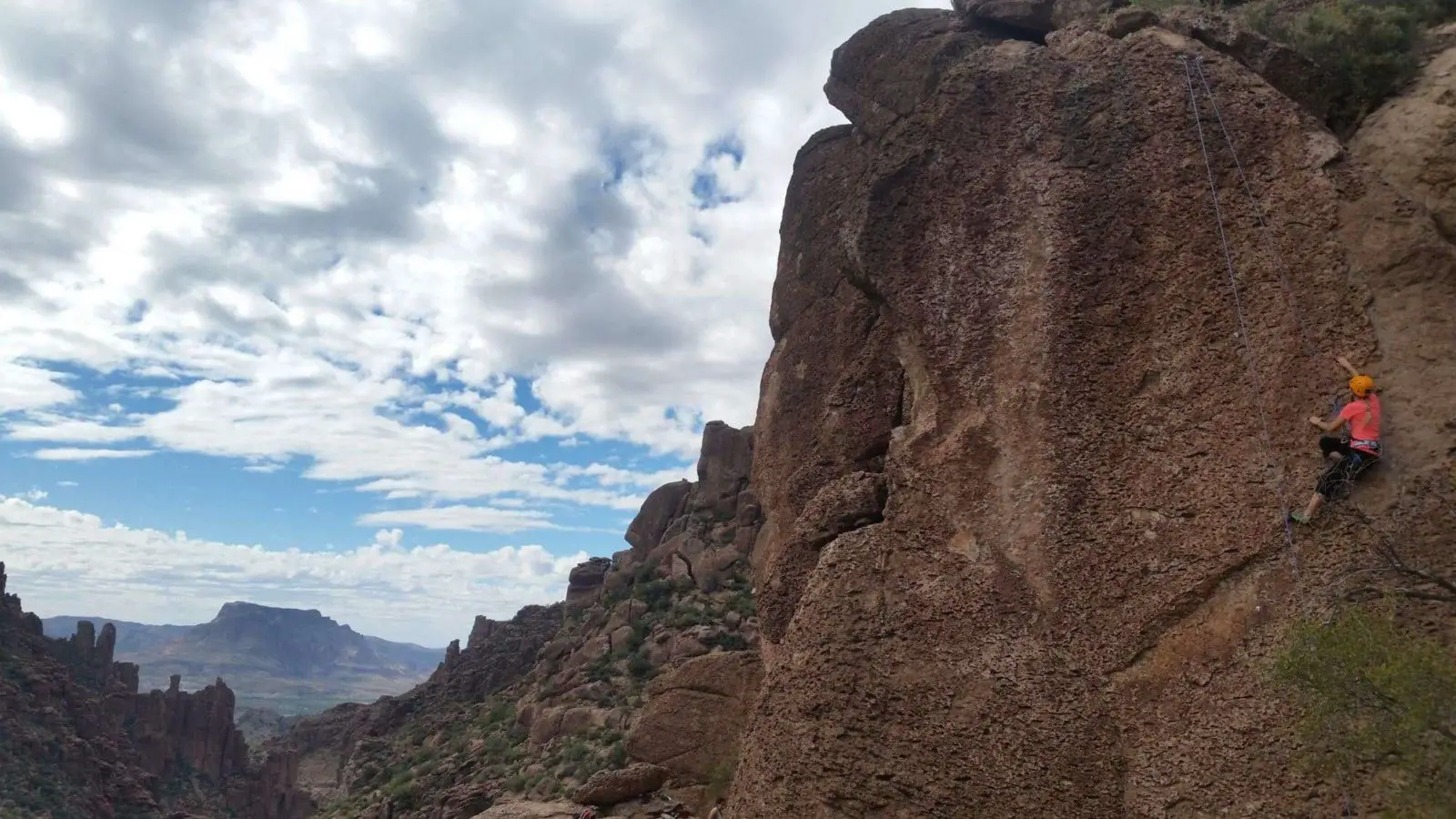Organized sports have grown incredibly since the beginning of the 20th century. While many of them consist of matching uniforms and pom-poms, many others are individual events with little or no publicity. Rock climbing has grown considerably in the last 20 years. What began as a means of accessing solitary places has matured into groups of thousands of people scaling rocks outdoors and pulling plastic indoors in gyms across the world.
Rock Climbing is considered a sport at the competitive level because of the physical exertion, skill, competitive nature, and entertainment value. Individuals or teams compete against each other in bouldering, lead climbing, and speed climbing, as well as other less popular events. For most climbers, it is more of a lifestyle or hobby and the majority of climbers never actually compete in organized competitions
There are winners and losers, competing requires physical exertion, and it provides entertainment for viewers and participants alike. Just because you haven’t seen rock climbing on ESPN (or have you? ) doesn’t make it less of a sport.
) doesn’t make it less of a sport.
Rock Climbing As a Competitive Sport
Now, just because competitive rock climbing is a sport doesn’t necessarily make rock climbing in general a sport. The majority of climbers will never join competitions, let alone compete professionally. The majority of cyclists and mountain bikers also don’t enter races, but we don’t question their legitimacy.
Just like shooting free throws or doing batting practice, climbing for fun is a big part of the overall sport of rock climbing. The competitive events in rock climbing are what give legitimacy to the overall activity as a sport, even though most of us don’t compete with anyone but ourselves.
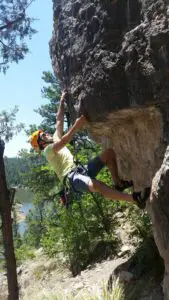
To me, rock climbing is a lifestyle sport. Some people live the basketball lifestyle with their dress, interests, and leisure time, while others live the surfing lifestyle. Many climbers wholly identify with the sport, and live accordingly. Training obsessively, dieting, and working with coaches have become more and more common. Climbers push the limits as they develop new technologies and techniques.
To me, the rock climbing is a competitive sport because I compete with my own best ascents and grades. If I were one of the best in the world though, I’d probably want to compete with others!
Why is Rock Climbing Considered a Sport?
The Oxford dictionary defines a sport as “activity involving physical exertion and skill in which an individual or team competes against another or others for entertainment“. Let’s take a look at each facet of that definition.
Physical Exertion
Sure, pretty much anyone can climb. The stronger you are (up to a certain point) will help you climb harder. Professionals train for hours every day on things like grip strength and flexibility, as well as cardio. Rock climbing is considered a full-body workout. Most indoor climbing gyms include areas set aside for pull-up and grip strength training.

In general, the more strength you have in relation to your body weight will help you climb better. A few interesting examples of differing body types include good friends and elite rock climbers Chris Sharma and Jason Momoa
and Jason Momoa . Sharma is lean and tall, whereas Momoa has a lot more muscle. Rock climbers are especially vulnerable to eating disorders- an indication that body shape and size are perceived to influence ability.
. Sharma is lean and tall, whereas Momoa has a lot more muscle. Rock climbers are especially vulnerable to eating disorders- an indication that body shape and size are perceived to influence ability.
Skill
While some people are naturally better at climbing than others, practicing and learning techniques clearly helps you become better. When I really started to get into climbing in my early twenties, I was thoroughly annoyed to see kids climbing harder than I was.
There is a lot more to climbing than strength. Just as in other sports, climbers train under coaches in order to develop the techniques required to take their skills to the next level.
Competition
The first official climbing competitions really began in the 1980’s. Of course prior to that there was always competition between friends and rivals. Mountaineering exploits, like being the first to climb Everest, have been around for longer than that.
In the modern era, competitions range from local gyms to the International Federation of Sport Climbing (IFSC). Many of the best climbers in the world got their start at the local level, progressing until they reached the global stage.
If rock climbing didn’t have organized competitions, then I wouldn’t consider it a sport. It could be akin to something like hiking, with physical exertion and skill, but no competition or entertainment (for others) factors.
Entertainment Value
As stated above, climbing competitions have recently begun airing on ESPN- the self-proclaimed “worldwide leader in sports.” Obviously they must think the market is big enough to support this brand of entertainment. Look no further than Alex Honnold’s documentary Free Solo  to see if climbing provides entertainment to the masses.
to see if climbing provides entertainment to the masses.
It actually doesn’t take much for something to qualify as a sport. In fact, “Lightsaber Dueling” is a recognized sport in France, and speed walking is in the Olympics. One of the biggest and fastest growing entertainment markets in the world is Esports, basically competitive gaming.
I would argue that Esports doesn’t meet the “physical exertion” criteria in the Oxford definition, but Dictionary.com (an athletic activity requiring skill or physical prowess and often of a competitive nature) and the name itself claim otherwise. Either way, they already make more money than the NBA, so I guess it doesn’t really matter if I think they qualify as a sport or not.
Olympic Legitimacy
In case you live under a rock (which, I guess, some dirtbag climbers do), rock climbing is an official Olympic event in 2021 in Tokyo. Different disciplines of climbing have been in the World Games since 2005. Although the Olympics do include some dubious events like Racewalking, Synchronized Swimming, and Equestrian, it’s hard to argue that something included in the Olympics isn’t a sport.
The announcement by the Olympic Committee in 2016 was met with a lot of excitement, as well as a feeling of betrayal by some climbers. This goes back to the climbing as a lifestyle idea- that adding the sport to the Olympics would negatively impact how some climbers live. While that may be true, climbers generally anticipate the increased exposure and interest that will be generated as a result of the Olympics.
2021 Sport Climbing Olympic Format
As more details came out about the format of the events, many Olympic hopefuls were frustrated. Rather than including a medal for every single style of climbing, like in sprinting or swimming, they are awarding one medal to the winner of the three events selected. Depending on its reception (and most definitely its viewership), we could see more medals and different events in the future.
The combined format for the 2021 Olympics is colloquially referred to as the “Vertical Triathlon.” The three events, bouldering, lead climbing, and speed climbing, are about as similar as running, biking, and swimming. You don’t see Michael Phelps winning triathlon medals.
The best speed climbers in the world aren’t necessarily the best at bouldering, and so on. While this is frustrating to some of the athletes, it lets others who are weak in an area or two to actually compete with the best. With only one gold medal, we find out who the overall best climber is!
Here’s a breakdown of the three sport climbing disciplines being tested in the Olympics:
Bouldering: Climbers go up a variety of problems in a fixed amount of time for each route (see description of bouldering below if you’re unfamiliar with it). Bouldering problems are usually much more difficult than regular routes, but also much shorter so they don’t require as much endurance. These are usually very technically challenging, and some moves are almost acrobatic.
Speed Climbing: Speed climbing is the least popular of the three among climbers. Most of the lifestyle climbers would never dream of racing; the thought of racing the exact same easy route over and over again sounds about as exciting as running sprints on a track!
The upside is that this is more appealing to a non-climbing audience because two people can race at the same time, and there’s an easier standard to compete against. With a more finite and clear measuring system, we could actually see world records being set and broken. It is mind-blowing to watch speed climbers, they fly up the wall and complete routes in a matter of seconds.
For more information on Speed Climbing, read all about it here- Is Speed Climbing Always the Same Route?

Lead Climbing: Lead climbing will be fun to watch for climbers, and will be terrifying for non-climbers. The goal is to climb as high as you can on a route that gets progressively more difficult. There will be a lot of falls, which is always fun to watch. This will answer the age-old question posed by other people of ‘don’t you ever get scared of falling?’
The Olympic trials have gone well so far, but it will be interesting to see how much this climbing format catches on with a global audience. There are 20 male athletes and 20 female athletes in this competition. I hope to see climbing continue to make the Olympics every four years moving forward, and am excited to see how the format is adjusted.
The History of Rock Climbing as a Sport
People have been climbing things for forever. Whether searching for safety, resources, or enlightenment, people have probably always climbed mountains and cliffs. Human nature is to look up at these high places and dream of reaching them. The most famous ascents by Victorian Era mountaineers during the ‘Golden Age of Alpinism’ led to the development of special gear specific to climbing. A lot of mountaineering is hiking, but most routes do require some climbing and vertical ascent as well.
The actual sport of rock climbing began in the late 1800’s in several places in Europe. Mountaineers wanted to train and practice specific ascension techniques without having to go all of the way up a peak. They started climbing cliffs and rocks closer to where they lived, and this started off rock climbing as a separate discipline. Various grading systems emerged around the world as an attempt at comparing routes. The famed Half Dome in Yosemite was first climbed using Aid Climbing techniques (see below) in 1875.
The early 1900’s saw the beginning of early climbing gear like pitons and carabiners . Nylon rope (see What is Climbing Rope Made Out of?)
. Nylon rope (see What is Climbing Rope Made Out of?)  emerged during World War II, and the first cam devices (see below in Trad Climbing) in the 1970’s. Companies devoted to climbing like Chouinard Equipment (now Black Diamond) started in this same timeframe, and have largely shaped the industry with a goal of sustainability and leave no trace ethics.
emerged during World War II, and the first cam devices (see below in Trad Climbing) in the 1970’s. Companies devoted to climbing like Chouinard Equipment (now Black Diamond) started in this same timeframe, and have largely shaped the industry with a goal of sustainability and leave no trace ethics.
Climbing grades have consistently increased, with the highest thought possible at 5.10 in the 1950’s and increasing by about .1 every decade. The most difficult grades right now are in the 5.15 range.
The first climbing gym was built in the 1960’s in England, using bricks as holds. The first one built in the US was in 1987 in Seattle, Washington. Since then, climbing gyms have popped up all over the world.
Organized climbing competitions have been around since the latter half of the 20th century, and take place all over the world now. Climbing is expected to continue to grow in popularity with younger generations, especially with a focus on healthy lifestyles and the recent visibility attained by the sport.
For more of the long history of Rock Climbing, read my comprehensive post- The Complete History of Rock Climbing
Different Climbing Styles and Sub-disciplines
Rock climbing, as with other sports, encompasses a wide variety of styles and disciplines. Just like how basketball players play one-on-one or twenty one or have 3-point shootouts, climbers trad climb, boulder, and do multi-pitch routes. Climbers also really appreciate ‘style points,’ like in soccer or basketball, when people redpoint, onsight, or even take a good whipper!
Free Climbing
Free climbing means that you start at the bottom of the cliff and work your way up with your own strength, using ropes and protection. It is different from Aid Climbing because you can’t use gear to pull yourself up. This is NOT Free Soloing, which does not include ropes.
Free Climbing is what everyone thinks of when they think of rock climbing, because it is what is most prevalent and popular. Gear, both permanent and temporary, is used in order to protect the climber from a fall, but not to help ascend.
Sport Climbing: Sport climbing is prevalent in gyms, as well as outside. Permanent, fixed bolts are drilled into the walls going up routes every 4-10 feet (1-3 meters). The lead climber uses quickdraws , a piece of webbing with carabiners on either end, to clip between the bolt and the rope as he or she ascends.
, a piece of webbing with carabiners on either end, to clip between the bolt and the rope as he or she ascends.
In the event of a fall in between bolts, the climber stops after falling past the previous bolt. The risks of an injury from a fall are pretty low, as dynamic climbing ropes  are designed to stretch a bit and absorb the impact. A variation of lead climbing is one of the Olympic events.
are designed to stretch a bit and absorb the impact. A variation of lead climbing is one of the Olympic events.
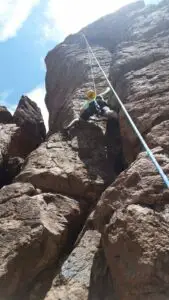
The majority of climbing done in climbing gyms is top-roping. This is where the rope starts out going through the top anchors, and there is minimal risk of falling more than a few feet (a meter). Climbing gyms have ropes set up at the top of each route, so the climber and belayer just have to tie in and get started.
Many gyms even have auto belay machines that function like a seatbelt- they retract as you climb up and let out if you want to lower, but stop completely if you slip or fall. Speed climbing is a type of top-roping where climbers race the exact same route, and is also a part of the Olympic trifecta.
Out in the wild however, top-roping is only possible when you can hike up to the top of the cliff, or after someone has already lead the route and fixed the rope in the anchors. Often, the best climber will lead a route and then rig the top-rope for other members of the group.
Trad (Traditional) Climbing: Trad climbing is also lead climbing, though much more complicated. Rather than just clipping quickdraws into permanent bolts, climbers wedge nuts and cams  (camelots) into cracks creating their own protection. Trad climbers may use permanent anchors at the top, or may rig their own anchors
(camelots) into cracks creating their own protection. Trad climbers may use permanent anchors at the top, or may rig their own anchors with gear.
with gear.
Purists like the idea of leaving nothing behind on the rock, as well as the heightened sense of healthy fear and adrenaline. There is a lot higher risk in trad climbing, as gear can shift or pop out if placed incorrectly- especially if the leader falls. Cams have come a long way, but still aren’t as solid as a fixed bolt. Ask any trad climber though, and they’ll tell you that this is part of the fun!
Multi Pitch Climbing: Climbing ropes are generally only 60 to 70 meters long on average. In order to climb anything higher than half of that rope length, you have to use multi pitch techniques. This means climbing up to an anchor, tying into it, and reverse-belaying your partner as he or she climbs up. This can be done as either sport climbing or trad climbing.
Solo Climbing
Solo climbing is basically climbing without ropes. Soloing comes in various forms. For simplicity, I include bouldering in this category. The three styles are Free Soloing, Deep Water Soloing, and Bouldering.
Free Soloing: Yes, this is dangerous. Yes, people die. Yes, a few people keep doing it. Free soloing is climbing cliffs without ropes or other protection. It is very uncommon because of the incredibly high risk, but some people still do it. Many people call it irresponsible and reckless, while others dream of trying it or applaud the bravado and romance of it.
The claim is that free soloing clears your mind of all distractions and allow you to become one with the rock…blah blah mumbo jumbo. While I do agree that Alex Honnold’s ascent of El Capitan’s The Nose in Yosemite National Park was one of the greatest athletic feats of all time, it is never something I would try myself. The risks are too great, and the likelihood of death or severe injury essentially inevitable. Either way though, Free Solo was a great documentary!
Bouldering: Free soloing short cliffs and large boulders is called bouldering. Even referring to this in the same category as free soloing is a stretch, but to me it’s where it best fits. Bouldering routes are called “problems.” Climbers start as low to the ground as possible, often sitting in the dirt or sand, and work their way up to the top of the problem.
These routes use a different rating system from sport climbing, ranging from V0 to V17 (for now until someone breaks it). Bouldering problems generally require a lot of technique, as well as arm strength. You are unable to take breaks without a rope to lean on, and a lot of climbs are inverted or overhung so you fall to the ground instead of on the rock you’re climbing. This takes a lot of additional upper body strength, as well as good footwork in order to stay glued to the rock.
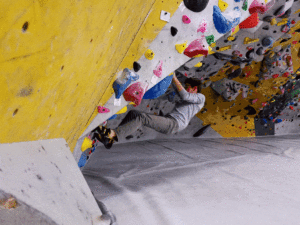
The nice thing about bouldering is that it is relatively cheap to do because you don’t need a rope and harness, or any hardware. With just a pair of climbing shoes , you can start climbing at a gym. Gyms rent out all of the gear you need as well, so try it out before committing.
, you can start climbing at a gym. Gyms rent out all of the gear you need as well, so try it out before committing.
Climbers use big thick pads, called crash pads or bouldering pads, to protect against falls. You can fall a long way and land on a thick pad and not get hurt. I’ve never seen people wearing helmets  while bouldering either. Usually climbers take turns spotting each other, which means basically catching the falling climber’s head and upper body and guiding them onto the pad. The higher the route, the more spotters you need to keep you safe.
while bouldering either. Usually climbers take turns spotting each other, which means basically catching the falling climber’s head and upper body and guiding them onto the pad. The higher the route, the more spotters you need to keep you safe.
Most climbing gyms have large bouldering areas where anyone can come alone and climb. It’s still best to have a spotter when available, but with big thick pads on the floors you shouldn’t get hurt. You should down climb a few feet when climbing anything above about 15ft (5m), and it’s important to learn how to land and roll as to not hurt your knees or ankles.
The main risk with bouldering is a sprained ankle or broken bone. I know two people who have broken legs bouldering, one in a gym when someone obliviously crossed beneath her as she fell, and one bouldering outside when he landed in between pads. Clear out the area beneath the problem before you get going, and practice falling from low heights before getting too high. Always use a spotter!
As mentioned above, bouldering is one of the events in the vertical triathlon of the Olympics.
Deep Water Soloing: Psicobloc, or “Psycho Bouldering,” is free soloing or bouldering over a body of water. This sport (sport, because there are competitions!) has really started gaining popularity in the last few years, largely thanks to professional climber Chris Sharma and his DWS in Mallorca, Spain. There are psicobloc world championships now (mostly done over deep swimming pools with artificial climbing walls), but the sport is still on the fringe.
Deep Water Soloing lets you get a taste for what it feels like to climb up high not using ropes, without the high risk of death. Don’t get me wrong- falling into water from 30ft (10m) up can still really hurt if you don’t land on your feet, but obviously a lot less than if you were hitting the ground.
You can fall a pretty long way before the water hurts you, but it’s really important to adjust your fall mid-air and land feet first. If you know you are going to fall, don’t let yourself belly-flop or land on your back.
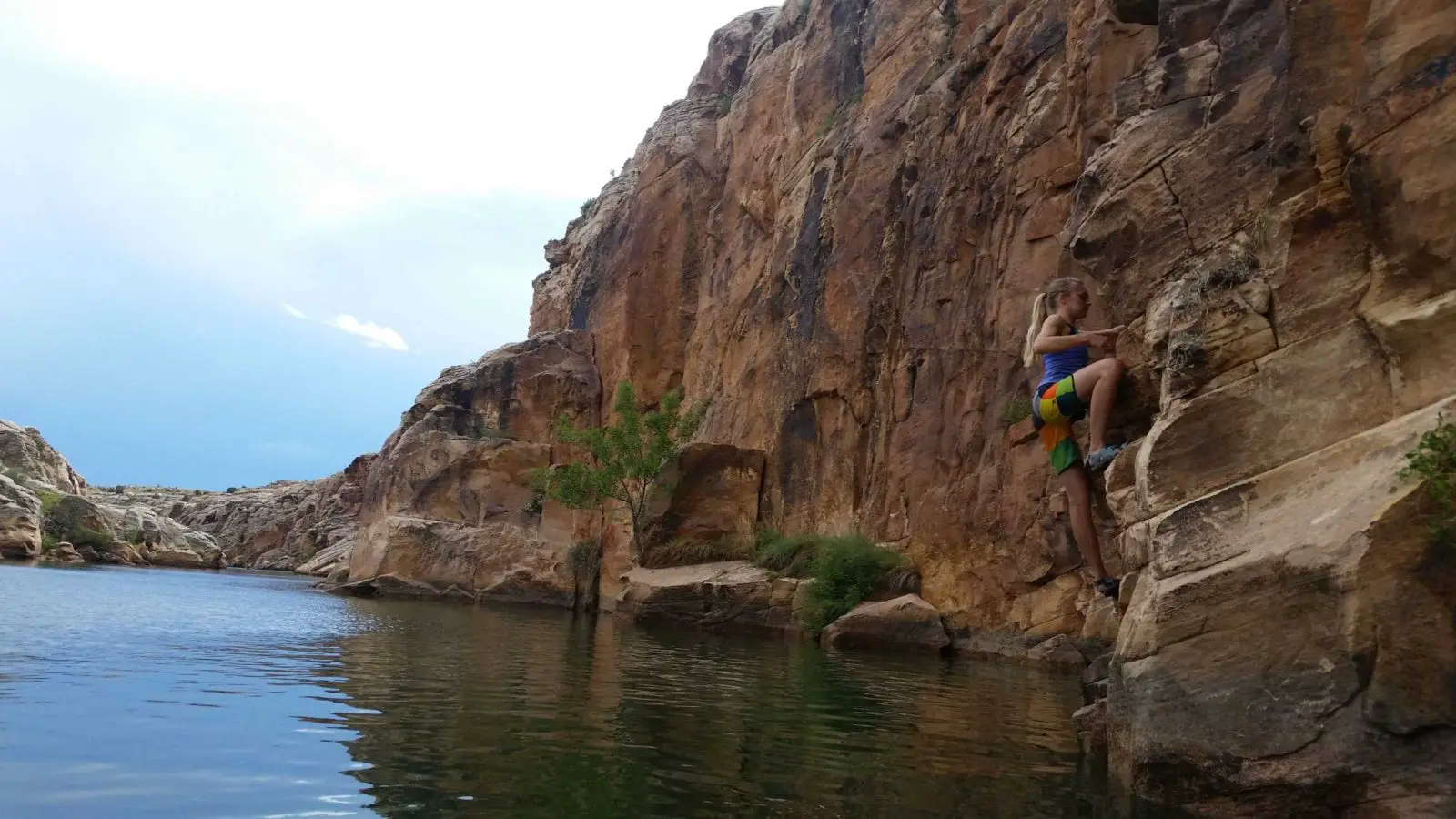
The most famous places to participate in Deep Water Soloing are in Mallorca and Thailand, both coastal regions. There are also a lot of areas where cliffs border inland lakes or rivers where you can try psicobloc. Make sure you test the depth of the water before jumping or falling in.
Murky water hides all kinds of rocks and logs, which could break bones–or worse. I’ve done all of my deep water soloing in Arizona, though I have plans to go to Spain or Portugal to climb on the coast in the future.
Check out this article  for more information on deep water soloing and how the water affects your climbing gear.
for more information on deep water soloing and how the water affects your climbing gear.
Aid Climbing
Aid climbing is what you see on a lot of big walls, like those found in Yosemite National Park. The original dirtbags who lived and spent time in the park spent weeks working their way up cliffs, hammering pitons into the rock and using aiders and other gear to hoist themselves up to the top. Siege tactics, basically attacking a mountain and doing everything possible to reach the top for days on end, are a type of aid climbing used to summit big walls.
Aid climbing is used more for ‘impossible’ routes mountaineering, or routes that couldn’t be completed by free climbers. Europe has a lot of routes with permanent ladders and cables called “Via Ferrata.” Many were originally set up to traverse impossible sections of hiking trails, but now a lot of them are guided tours.

Conclusion
Climbing is most definitely a sport. Maybe not in the way that most climbers participate in it, as they don’t do a lot of competing, but rock climbing is an awesome sport for anyone to start. There are a lot of different variations of climbing, and each has its own intricacies. Though it is largely an individual sport, you pretty much always have to have another person with you in order to participate.
As climbing teams train and start from younger ages, we can expect to see changes in the sport. From the crag to the gym, climbers are always pushing the grades they send, and striving to improve. We’ll see what the next generation of climbers brings!
Related Questions:
Is Rock Climbing a Sport in the Olympics? Rock Climbing as an official Olympic sport will debut in the 2021 Tokyo Olympics. The medal will be comprised of 3 events, speed climbing, lead climbing, and bouldering. Future Olympics may keep this controversial format, or may change it to maximize viewership.
Is Indoor Rock Climbing a Sport? Rock climbers compete head-to-head indoors during competitions in a variety of ways. The sport includes lots of different ways of competing, including races and challenges of increasing difficulty. Climbing as a sport is growing rapidly around the world as techniques improve safety and indoor gyms become more common.
What Kind of Sport is Rock Climbing? The sport of rock climbing is an adventure sport and can be compared to mountain biking or trail running. The vast majority of participants never compete in official competitions, though official circuits exist and attract attention. Rock Climbing and its sub-disciplines like bouldering are becoming more and more popular each year.
See Also:
How Many People Die Rock Climbing?

